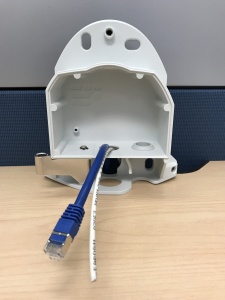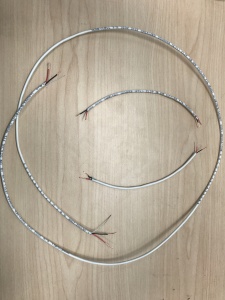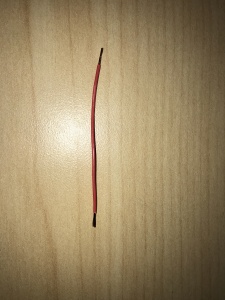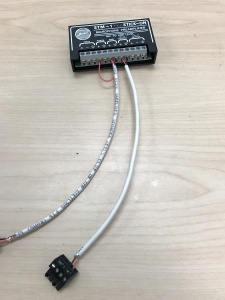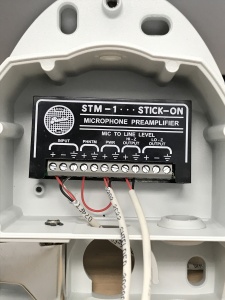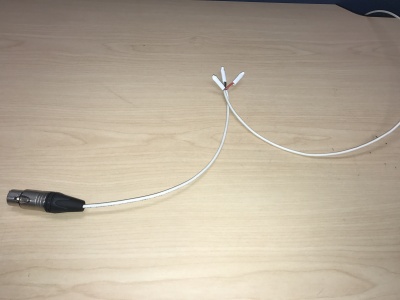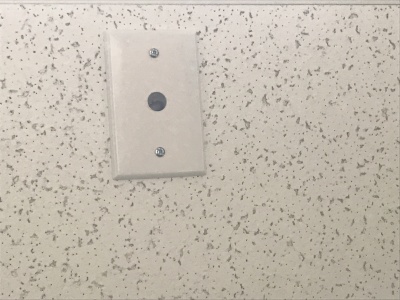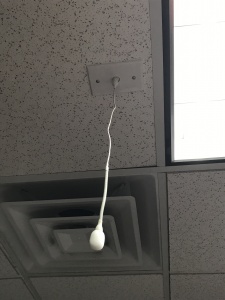Installing an Axis P5414/P5415 with a Shure MX202i Microphone
Contents
Required Parts And Tools
- Axis P5415 or P5415
- RDL STM-1
- XLR-F Pigtail
- Shure MX202i Microphone
- S2 TT20 Torx security bit
- Wire Stripper
- Anchors and Screws
- 1/2" paddle bit
- 1 blank single gang wall plate
- Toggle Bolts (If mounting to drop ceiling tile)
- Drill bit and drill
- Phillips head drill bit or Phillips head screwdriver
- Small Flat head screwdriver
- Hole Saw
- B Connectors
- Stud Finder
- Cat5/6 Patch Cable (7ft-15ft recommended)
- 22/2 Gauge Wire
- Fish Tape or Glow Rod
- Wind Screen (Inside MX202i Box)
- Rubber Stopper (Inside MX202i Box)
- 4 pin XLR-M to XLR-M Adapter (Inside MX202i Box)
Installation Instructions
- Locate the network drop above the ceiling either being a male Ethernet end (service loop) or a biscuit jack. This will have been ran back to the POE switch providing High POE (requires up to 37W for PTZ functions). If the switch does not have High POE, a POE injector will need to be installed at the network closet.
- Using a stud finder, ensure there aren’t any studs where the camera will be omunted. Remove the P5414/P5415 camera from its base with the T20 bit. Using a small Phillips head screwdriver, remove the plastic ring around the base of the camera dome. Then, using the T10 bit, remove the camera dome and remove the protective foam. Reattach the dome and snap the plastic ring back into place.
- While holding the camera base plate where it will be mounted, use a pencil to mark the 4 areas on the wall where the screws will be located. Also mark the opening where the any cabling would pass through (see image below).
- Using the drill bit, drill the 4 screw marks and insert mounting anchors. Using the hole saw (recommended size 2” inches or less), drill a hole into the area where cables will pass through.
- Above drop ceiling, locate the network drop. If it is on a biscuit, you will need the patch cable. If there is an RJ-45 at the end of the drop, the patch cable won’t be needed. Using the hole saw, drill a hole above the drop ceiling in line with the hole drilled where the camera will be mounted. If there isn’t any drywall above the ceiling, adjust accordingly to your circumstance.
- Using glow rods or fish tape, fish the network drop and 2 sections of 22/2 audio cable down the drywall. The sections of audio cable should be long enough to reach the destination where the STM-1 preamp will be mounted in your drop ceiling. One will be for audio to the camera; the other will be to power the STM-1.
- Mount the Axis P5414/5415 base to the wall using the screws associated with the anchors. Remove the middle rubber piece on the camera base and run the network drop and any other cabling through this hole.
- Strip the jacket off the 2 runs of 22/2, revealing the red, black, and common (bare wire). Remove the string and plastic casings covering the red and black cables. Strip the red and black jackets off the wire exposing the copper. Cut copper evenly on both ends (See picture). On the cable for power, remove the common (bare wire) completely.
Connecting the STM-1
- Cut a short piece of 22/2 cable (approx. 1 inch). Strip the jacket and from the cable and remove all contents keeping only the red cable. On both ends of the red cable, strip off a piece of the jacket (See picture).
- Connect one end of the 1 inch audio cable to the +PWR terminal and connect the other end of that into the +PHNTM terminal.
- Connect the cable we ran for power to both PWR terminals (Red to +, Black to the other terminal) of the STM-1. Connect the other side to the IO phoenix connector (Red to 2, Black to 1).
- Connect the cable we ran for audio to both HI-Z OUTPUT terminals (Red to +, Black to the other terminal) of the STM-1. Connect the other side to the audio in portion of the audio phoenix connector (Red to +, Black to –).
- We will need another length of 22/2 cable intended for your microphone; connect it to the input terminals of the STM-1 (Red to +, Black to -, ground to the ground terminal). Using the Velcro that comes with the STM-1, attach the STM-1 to the wall above drop ceiling hidden from sight.
(NOTE; If there are 2 cameras in the room, duplicate these steps to get to the 2nd camera. HI-Z output can feed 2 cameras, but no more. If there are 2 Shure MX202i Microphones, duplicate steps. An STM-1 can power and gather audio from 2 Shure 202i mics.)
Connecting and Mounting the Microphone
- Strip the jacket of the XLR pigtail revealing the red, black and common cables inside. Strip away a portion of the red and black cables inside the pigtail, revealing the copper wire inside. At the end of your 22/2 cable (connected to the STM-1), twist the wires together with the pigtail (red to red, black to black, common to common). Secure these with B-Connectors (See Pictures). Repeat this process for 2 microphones.
- Drill a hole into the center of the single gang plate using the ½” paddle bit, and a hole into the desired location for the microphone on your drop ceiling tile with a 1" paddle bit. Then secure this single gang plate to the desired location of the microphone on your drop ceiling tile using a pair of toggle bolts.
- Run your MX202i through the ½” hole in the ceiling tile and single gang plate. Connect the 4 Pin XLR-F end of the MX202i to the 4 pin XLR-M adapter. Next, connect the XLR-F (that is ran back to the STM-1) to the XLR-M of the adapter. Use the rubber stopper to plug the ½” hole in the single gang plate.
- Lastly, adjust the length of the cable of the microphone to your desired length, hiding the remainder in the ceiling near the STM-1. Attach the windscreen to the MX202i.














